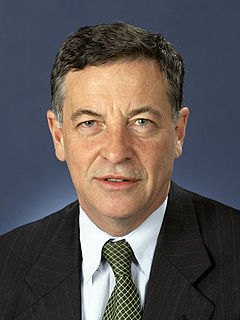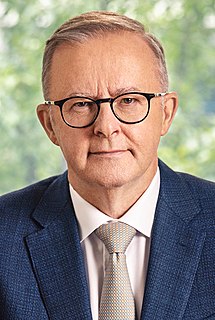
The Senate is the upper house of the bicameral Parliament of Australia, the lower house being the House of Representatives. The composition and powers of the Senate are established in Chapter I of the Constitution of Australia. There are a total of 76 senators: 12 are elected from each of the six Australian states regardless of population and 2 from each of the two autonomous internal Australian territories. Senators are popularly elected under the single transferable vote system of proportional representation.

The 2004 Australian federal election was held in Australia on 9 October 2004. All 150 seats in the House of Representatives and 40 seats in the 76-member Senate were up for election. The incumbent Liberal Party of Australia led by Prime Minister of Australia John Howard and coalition partner the National Party of Australia led by John Anderson defeated the opposition Australian Labor Party led by Mark Latham.

The Liberal–National Coalition, commonly known simply as "the Coalition" or informally as the LNP, is an alliance of centre-right political parties that forms one of the two major groupings in Australian federal politics. The two partners in the Coalition are the Liberal Party of Australia and the National Party of Australia. Its main opponent is the Australian Labor Party (ALP); the two forces are often regarded as operating in a two-party system. The Coalition was last in government from the 2013 federal election, before being unsuccessful at re-election in the 2022 Australian federal election. The group was led by Scott Morrison until the 2022 Australian federal election, where he resigned as leader. His successor is Peter Dutton.
This is a list of members of the Australian Senate from 1 July 1981 to 5 February 1983. Half of the state senators were elected at the December 1977 election and had terms due to finish on 30 June 1984; the other half of the state senators were elected at the October 1980 election and had terms due to finish on 30 June 1987. The territory senators were elected at the October 1980 election and their terms ended at the dissolution of the House of Representatives, which was March 1983. However, in fact, the Senate was dissolved on 4 February 1983 for a double dissolution election.
This is a list of members of the Australian Senate from 1 July 1978 to 30 June 1981. Half of the state senators were elected at the December 1975 election and had terms due to finish on 30 June 1981; the other half of the state senators were elected at the December 1977 election and had terms due to finish on 30 June 1984. The territory senators were elected at the December 1977 election and their terms ended at the dissolution of the House of Representatives, which was October 1980.

The 1977 Australian federal election was held in Australia on 10 December 1977. All 124 seats in the House of Representatives and 34 of the 64 seats in the Senate were up for election.

The 2010 Australian federal election was held on Saturday, 21 August 2010 to elect members of the 43rd Parliament of Australia. The incumbent centre-left Australian Labor Party led by Prime Minister Julia Gillard won a second term against the opposition centre-right Liberal Party of Australia led by Opposition Leader Tony Abbott and Coalition partner the National Party of Australia, led by Warren Truss, after Labor formed a minority government with the support of three independent MPs and one Australian Greens MP.

The following tables show state-by-state results in the Australian Senate at the 2007 federal election, 37 Coalition, 32 Labor, five Green, one Family First, and one independent, Nick Xenophon. Senators are elected for six-year terms, and took their seats from 1 July 2008, but senators representing the territories have three-year terms and take their seats immediately.
This is a list of members of the Australian Senate from 1975 to 1978. The 13 December 1975 election was a double dissolution of both houses, with all 127 seats in the House of Representatives, and all 64 seats in the Senate up for election. Malcolm Fraser had been commissioned as prime minister following the dismissal of Gough Whitlam's Labor government by Governor-General Sir John Kerr, on 11 November 1975. The same day, Fraser advised the calling of the election, in accordance with Kerr's stipulated conditions. Thus the Liberal Party of Australia, led by Fraser, with Coalition partner the National Country Party, led by Doug Anthony, went to the election as a caretaker government. The election resulted in the Coalition securing government with a 30-seat swing away from Labor in the House of Representatives.
This article provides information on candidates who stood for the 1980 Australian federal election. The election was held on 18 October 1980.
This article provides information on candidates who stood for the 1983 Australian federal election. The election was held on 5 March 1983.

The 2013 Australian federal election to elect the members of the 44th Parliament of Australia took place on 7 September 2013. The centre-right Liberal/National Coalition opposition led by Opposition leader Tony Abbott of the Liberal Party of Australia and Coalition partner the National Party of Australia, led by Warren Truss, defeated the incumbent centre-left Labor Party government of Prime Minister Kevin Rudd by an 18-seat 3.6 percentage point two-party swing resulting in a landslide win for the Coalition. Labor had been in government for six years since first being elected in the 2007 election. This election marked the end of the Rudd-Gillard-Rudd Labor government and the start of the 9 year long Abbott-Turnbull-Morrison Liberal-National Coalition government. Abbott was sworn in by the Governor-General, Quentin Bryce, as Australia's new Prime Minister on 18 September 2013, along with the Abbott Ministry. The 44th Parliament of Australia opened on 12 November 2013, with the members of the House of Representatives and territory senators sworn in. The state senators were sworn in by the next Governor-General Peter Cosgrove on 7 July 2014, with their six-year terms commencing on 1 July.

The following tables show state-by-state results in the Australian Senate at the 2004 federal election. Senators total 37 coalition, 28 Labor, four Green, one Family First, two non-coalition National and four Democrats. Senator terms are six years, and took their seats from 1 July 2005, except the territories who took their seats immediately.

This is a list of members of the Australian Senate following the 2016 Australian federal election held on 2 July 2016. The election was held as a consequence of a double dissolution in which both houses of parliament were dissolved. Ordinarily, only half of the senators terms end at each election. In this case, all 76 senators were elected. At the first sitting following the election, half of the senators representing each of the six states of Australia were allocated six-year terms to end on 30 June 2022, with the remainder allocated three-year terms to end on 30 June 2019. The terms of senators from the Australian Capital Territory and the Northern Territory end on the day of the next federal election.</ref>

The following tables show state-by-state results in the Australian Senate at the 1996 federal election. Senators total 35 coalition, 29 Labor, two Green, two non-coalition National, seven Democrats, and one Independent. Senator terms are six years, and took their seats from 1 July 1996, except the territories who took their seats immediately.

The following tables show state-by-state results in the Australian Senate at the 1987 federal election. This election was a Double dissolution, which means that all 12 senators from each state were up for election. Senators total 29 coalition, 32 Labor, one Jo Vallentine Peace Group, four non-coalition National, seven Democrats, one Nuclear Disarmament and one Independent. Territory Senators served until the next federal election. State Senator terms were nominally three or six years, backdated from 1 July 1987. The Senate used the order-elected method to allocate three- and six-year seats, despite provisions for the AEC to conduct a special recount.

The following tables show state-by-state results in the Australian Senate at the 1984 federal election. Senators total 29 coalition, 34 Labor, one Nuclear Disarmament Party, four non-coalition National, seven Democrats, and one Independent. Senator terms are six years, and all took their seats immediately due to the expansion of the senate from 64 to 76 members.

The next Australian federal election will be held some time in or before 2025 to elect members of the 48th Parliament of Australia. All 151 seats in the House of Representatives and likely 40 of the 76 seats in the Senate will be contested. It is expected that at this election, the Labor government of Prime Minister Anthony Albanese will be seeking re-election to a second term in office, opposed by the Liberal/National Coalition under Leader of the Opposition Peter Dutton.

The 2022 Australian federal election in the Senate was held on 21 May 2022 to elect 40 of the 76 senators in the Australian Senate, after a six-week campaign. Senators elected at this election are scheduled to take office on 1 July 2022, with the exception of the Senators elected from two territories whose terms commence from election day. The elected senators sit alongside continuing senators elected in 2019 as part of the 47th Parliament of Australia.















